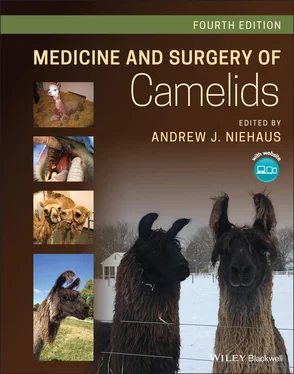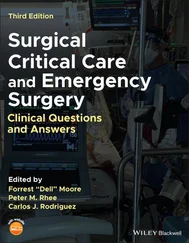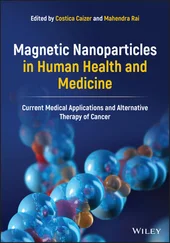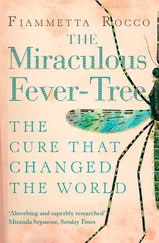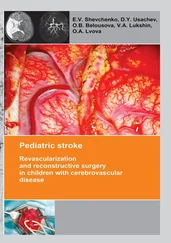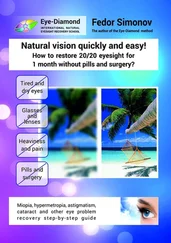1 Cover
2 Title Page
3 Copyright Page
4 Dedication Page
5 List of Contributors
6 Preface
7 About the Companion Website
8 1 General Biology and Evolution Taxonomy General Biology and Genetics South American Camelids Camels Evolution Domestication Uses of Camelids References
9 2 South American Camelid Behavior and the CAMELIDynamics Approach to Handling Camelid Behavior Containment Vs. Restraint The Midline Catch, bracelet and Handler Helper The Neck Wrap – A Thunder Shirt for Camelids Trimming Toenails Handling for Veterinary Procedures No‐Restraint Injections Techniques for No Restraint Injections Injections for Babies and Weanlings Drawing Blood Rectal Palpation and Transrectal Ultrasound Transabdominal Ultrasound Exams Physical Exams Procedures Involving the Head Oral Medication Eye Medication Trimming Fighting Teeth and Incisors Microchipping Earring Sedation Halter Fit Understanding Male Behavior in Camelids Pen Size and Shape Berserk Male Syndrome or Novice Handler Syndrome? The Novice Handler Syndrome Further Readings References
10 3 Feeding and Nutrition Anatomy and Nutritional Adaptations Camelid Digestive Process Nutrient Requirements of Camelids Feeding Behavior and Intake Capacity Forages and Feed Supplements Feeding Management Dietary Evaluation Nutrition Related Diseases References
11 4 Physical Exam and Diagnostics Physical Exam Diagnostic Procedures References
12 5 Radiology Introduction Making Radiographs Degenerative Joint Disease Septic Arthritis Sequestra Shoulder Making Skull Radiographs Tooth‐Root Abscesses Bulla Disease Rickets Normal Images References
13 6 Anesthesia and Pain Management Pre‐operative Assessment Sedation Field Anesthetic Techniques Inhalant Anesthetic Techniques Monitoring and Supportive Therapy during Anesthesia Recovery Anesthetic Complications Analgesia Local Anesthesia References
14 7 Parasitology External Parasites Myiasis Internal Parasites Nematodes of Other Body Systems References
15 8 Multisystem Disorders Neoplasia Stress Hyperthermia Hypothermia Fluid Therapy in Llamas and Alpacas Failure of Predicted Growth and Weight Loss References
16 9 Integumentary System Normal Camelid Skin Hair (Fiber, Wool) Skin Glands Diagnosis of Dermatologic Conditions Diseases of the Integument Fungal Infections Bacterial Infections Nutritional Skin Diseases Miscellaneous Dermatoses Neoplastic and non‐neoplastic tumors The Foot Foot Diseases of Camelids Mammary Gland The Ear References
17 10 Musculoskeletal System Specific Conditions Disorders of Joints Bone Sequestra References
18 11 Respiratory System Overview of the Camelid Respiratory System Nasolacrimal Duct Physiology SAC Adaptations to Altitude Diagnostic Procedures Infectious Diseases Parasitic Diseases Congenital Disorders Miscellaneous Diseases [75–77] References
19 12 Digestive System and Abdomen Anatomy and Physiology Gastrointestinal Tract Clinical Signs Associated with Digestive Disorders Diseases of the Digestive System Diseases of the Pharynx and Esophagus Abdominal and Gastrointestinal Surgery References
20 13 Endocrine System Endocrine Organs Endocrine Disorders References
21 14 Hematology, Clinical Biochemistry, and Fluid Analysis CBC Erythrocytes Leukocytes Platelets and Coagulation Hematopoietic Neoplasia Bone Marrow Flow Cytometry and Immunohistochemistry Immunodeficiency Disorder in Juvenile Llamas Biochemistry Peritoneal and Pleural Fluid Analysis Cerebrospinal Fluid (CSF) Analysis References
22 15 Cardiovascular System Anatomy and Physiology Special Diagnostic Procedures Diseases References
23 16 Reproduction and the Reproductive System Reproductive Strategies Normal Reproduction Physiology Pregnancy Parturition Involution of the Uterus [79] Camel Reproduction Postpartum Complications Obstetric Procedures [85] Pregnancy Termination Infertility [91] Treatment of Infertility and Metritis Infertility Conditions of Female Camels Assisted Reproductive Techniques [17, 25, 117, 118] Selection of Breeding Camelids Reproductive Surgery Acknowledgments References
24 17 Urinary System Anatomy Characteristics of Camelid Urine Diagnostic Procedures Urination Behavior Diseases References
25 18 Ophthalmology Anatomy of the Eye Ophthalmic Diagnostic Procedures Diseases of the Eye References
26 19 Nervous System Diagnosis Common Neurologic Diseases Less Common Neurologic Diseases Non‐specific Therapy Plan for Neurologic Disease References
27 20 Neonatology Prepartum Care Characteristics of the Camelid Neonate Immediate Care of the Newborn Care Given to the Dam Prematurity Immunoglobulins Failure of Passive Transfer (FPT) of Immunoglobulins Caring for the Orphaned Camelid Weaning Neonatal Diseases and Conditions Congenital Defects (Partial List) Immunoprophylaxis Routine Husbandry Practices Acknowledgments References
28 21 Congenital/Hereditary Conditions Terminology Teratogenesis Hereditary Traits Congenital Conditions New Congenital Defects of SACs Camelid Hybrids References
29 22 Toxicology Adaptation to Toxicants Diagnosis of Poisoning Prevention of Poisoning Treatment of Poisoning Antidotes Specific Toxins References
30 23 Old World Camelids Behavior and Handling Sedation Routine Veterinary Care Reproduction Diseases of Camels Surgery of Camels References
31 Index
32 End User License Agreement
1 Chapter 1 Table 1.1 Taxonomic classification of common Artiodactyla a. Table 1.2 Characteristics of South American camelids. Table 1.3 Weights and sizes of South American camelids. Table 1.4 Characteristics of camels. Table 1.5 Approximate number of years that certain animals have been domesti...
2 Chapter 2 Table 2.1 Behaviors typical of South American camelids when calm and fearful...
3 Chapter 3 Table 3.1 Characterization of microbial populations and associated metabolic... Table 3.2 Water requirements for llamas and alpacas. Table 3.3 Total dissolved solids or substances (TDS) as a measure of water q... Table 3.4 Water quality guidelines for livestock based on dissolved mineral ... Table 3.5 Nutrient requirements for South American camelids. a Table 3.6 Nutrient requirements for dromedary camels. a Table 3.7 Summarized macromineral functions and disease conditions. Table 3.8 Recommended macromineral requirements for South American camelids. Table 3.9 Summarized micromineral functions and disease conditions. Table 3.10 Recommended micromineral requirements for South American camelids... Table 3.11 Composition of Peruvian llama and alpaca pasture plants. Table 3.12 Chemical composition of selected plants eaten by dromedary camels... Table 3.13 Calculated forage intake as a percent of body weight (% BW) based... Table 3.14 Comparison of the nutrient composition of grasses cut at the same... Table 3.15 Composition of selected grasses used for pasture and hay in feedi... Table 3.16 Nutrient composition of legumes cut at 1/10 bloom (all values on ... Table 3.17 Nutrient composition of legumes forages for llamas and alpacas. a,... Table 3.18 Suggested dietary composition for SAC feeding groups.Table 3.A.1 Conversion of conventional units to Système International units ...Table 3.A.2 Glossary of terms used in feeding and nutrition.
4 Chapter 4Table 4.1 Checklist of basic data to collect for any examination.Table 4.2 Checklist for physical examination of llamas and alpacas.Table 4.3 Typical weight and height of camelids.Table 4.4 Physical exam parameters of camelids.Table 4.5 Orogastric tube sizes for llamas and alpacas.Table 4.6 Synovial fluid reference ranges for camelids.
5 Chapter 5Table 5.1 Technique chart used at The Ohio State University for making digit...
6 Chapter 6Table 6.1 Endotracheal tubes for camelids.
7 Chapter 7Table 7.1 External parasites of South American camelids [3, 80].Table 7.2 Protozoan parasites of camelids [3, 80].Table 7.3 Coccidia of South American camelids.Table 7.4 Coccidia of camels.Table 7.5 Trematode and cestode parasites of camelids [3, 80].Table 7.6 Nematode parasites of camelids [3, 80].Table 7.7 Anthelmintics used in camelids [5].
Читать дальше
